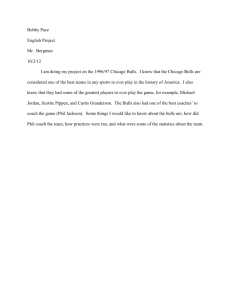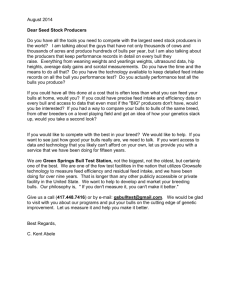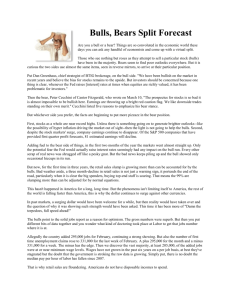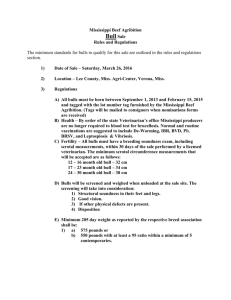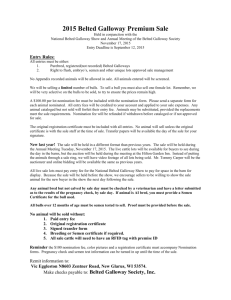Selection & Judging Guide - Australian Galloway Association
advertisement
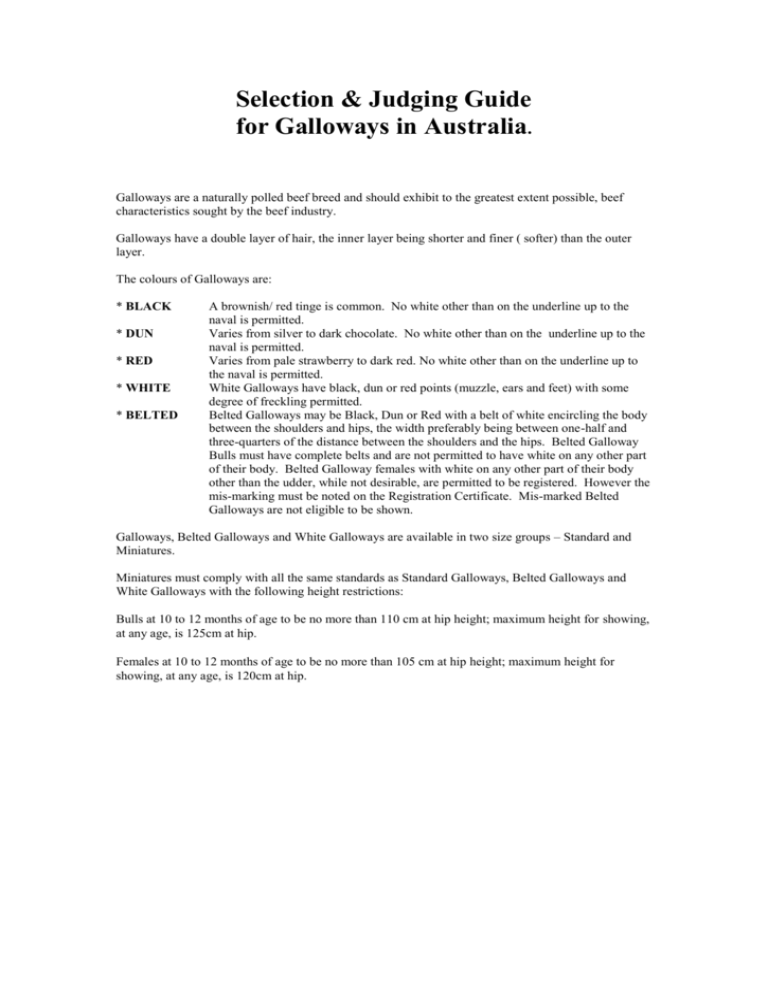
Selection & Judging Guide for Galloways in Australia. Galloways are a naturally polled beef breed and should exhibit to the greatest extent possible, beef characteristics sought by the beef industry. Galloways have a double layer of hair, the inner layer being shorter and finer ( softer) than the outer layer. The colours of Galloways are: * BLACK * DUN * RED * WHITE * BELTED A brownish/ red tinge is common. No white other than on the underline up to the naval is permitted. Varies from silver to dark chocolate. No white other than on the underline up to the naval is permitted. Varies from pale strawberry to dark red. No white other than on the underline up to the naval is permitted. White Galloways have black, dun or red points (muzzle, ears and feet) with some degree of freckling permitted. Belted Galloways may be Black, Dun or Red with a belt of white encircling the body between the shoulders and hips, the width preferably being between one-half and three-quarters of the distance between the shoulders and the hips. Belted Galloway Bulls must have complete belts and are not permitted to have white on any other part of their body. Belted Galloway females with white on any other part of their body other than the udder, while not desirable, are permitted to be registered. However the mis-marking must be noted on the Registration Certificate. Mis-marked Belted Galloways are not eligible to be shown. Galloways, Belted Galloways and White Galloways are available in two size groups – Standard and Miniatures. Miniatures must comply with all the same standards as Standard Galloways, Belted Galloways and White Galloways with the following height restrictions: Bulls at 10 to 12 months of age to be no more than 110 cm at hip height; maximum height for showing, at any age, is 125cm at hip. Females at 10 to 12 months of age to be no more than 105 cm at hip height; maximum height for showing, at any age, is 120cm at hip. BULLS The important physical traits are : Fertility, Skeletal Size, Structural Soundness, Muscling & Body (or growth) Capacity. 1. Fertility The most important rating a bull can receive is high fertility. Physically we can examine several traits which indicate high fertility. In order to cover quickly and seek out cows, a bull must have good clear eyes, sound feet and legs, and a skeletal frame built for longevity. He must have a good sized scrotal sac with the testes fully descended, with the scrotum descending well down, and the scrotal sac should have a distinct neck. The normal circumference range of a one year-old bull is 32 – 34 cm. A year-old bull with a circumference of less than 30cm and a two year-old with less than 34 cm would be less than satisfactory. Bulls should be clean sheathed. 2. Skeletal Size Frame size is highly heritable and easily assessed. The Galloway breed requires balance and sire characteristics present in our bulls. We want balanced height, length and adequate body capacity, depth of rib, substantial bone and a symmetrical leg size to fit this body. We do not want a very tall, shallow ribbed, narrow framed body which obviously lacks body capacity, but may have extreme size. We also do not want a short thick body with extreme depth of middle and carrying excess fat. Obviously when selecting Miniatures these traits should be taken into consideration within the overall height restrictions. 3. Structural Soundness This area is difficult to determine and so the judge’s instinct and good cattle sense and knowledge come into play. Bad defects which could cause problems are clearly evident. The problems are straight prominent shoulders, small inside toes and hooves which turn in, all cause a short constricted stride which is evident as the bulls parade. Post legs with straight pasterns are observed when the bulls are stationary and this may lead to weakness in the stifle joint. Great attention should be paid to the bull’s hocks. If they are too close, the overall body capacity will be small, if they are bent either in or out then problems will arise. Careful observation of the strength of the stifle muscle will give an indication of the strength of the stifle joint, and if this strength is evident then the bull will have a good reach with the hind legs when parading and will show the correct flexibility in his hocks. Standing in front of the bull, if you observe his front legs are too close he will have insufficient heart, lung and body capacity. From the same observation position, the outline of his hind quarters should be visible and not obscured by prominent shoulders. The bull should have a strong sire’s head and outlook; he should hold his head up proudly when parading and at rest; he should have good bold eyes set wide apart and with adequate balancing length of head, a broad muzzle and of course a sound underjaw. 4. Muscling There are two problems in this area, either too little or too much. Too little muscle will be readily evident with prominent shoulder blades, a sloping or inverted V shape along the back bone and concave butts. Bulls with extreme muscling are associated with calving difficulty, restricted freedom of movement and low fertility, particularly if double muscling is evident. Bulls with the appropriate amount of muscle will have: a. a nice wide comfortable stance in front and behind. b. a prominent bulging forearm, stifle and jump muscle viewed when the bull is at rest and moving. c. the loin muscle should be deep and wide 5. Body Capacity The best bulls have excellent chest and barrel capacity. Depth, spring of rib and good body capacity is necessary for maximum weight gain and durability. Extremely tall, thin, tight wound, extreme type cattle do not have this capacity. Performance Data. When available, performance data should be considered. Important weights are: Birth Weight for ease of calving; Weaning Weight to indicate mother’s milking ability and Yearling Weight to indicate growth potential. These traits are highly heritable and are good indicators of the bull’s breeding value. The Sire. The modern herd sire should have adequate height for his length of body. He should have every indication of free movement and fertility. He should have adequate frame, good strong sound structure, ideal muscle and fat composition and body capacity, as it relates to maximum efficient beef production. He should be trim in the brisket and underline. If in doubt ……. Handle the cattle FEMALES When judging females the emphasis is much the same as with the males. The main points to consider are: Fertility, Longevity, Milking Ability, Body Shape, Size & Capacity. 1. Fertility Obviously the function of a cow is to produce and feed a live calf each year of her breeding life. A highly fertile cow usually has a graceful and feminine appearance. She will be well balanced and graceful in her movements. She will be lean and clean in her face, neck and throat and will be long and smooth in her muscling. She will be lean and trim in her brisket, over her shoulders and flanks. She should be long from her hips to pins and with a long, elegant, graceful neck. She should be high and wide at her pins. Cows with low fertility are generally coarse fronted, unbalanced with extremely deep and coarse shoulders and will be over-conditioned. Her udder will appear to be non-functional and will be drawn up tight against her underbelly. 2. Longevity To indicate longevity a female should be sound in her feet and legs and should not have any lameness or swollen joints. The females should exhibit good clean strong bone and joints. The muscles connecting their hip, stifle and other joints should be long, smooth and pliable to give the cow every chance of avoiding injury or suffering from arthritis. 3. Milking Ability The mammary system should show a strong and evenly attached udder of good capacity and strength with moderate sized teats of even shape and dark colour. Avoid poor capacity, deep, bulgy or loosely attached or unevenly shaped udders with teats that are too big, too small or of odd and uneven shape. A cow should give sufficient, high protein milk to rear a first class calf. 4. Body Shape, Size and Capacity The ideal cow will be large enough with a deep-ribbed, wide sprung chest with an adequate body capacity. She will have a total balance, being long and smooth in her shoulder and neck and long from her hook to pin. She will be wide between her pins and show a large pelvic capacity. She should have a deep jaw, broad muzzle with a nice growth appearance to her head. Heifers that are short headed, coarse and heavy fronted and which give the impression of masculinity rather than femininity, even though they are extremely well muscled, are not desirable. Whether Standard size or Miniature, the female should be balanced according to her size. EVALUATION OF STEERS To correctly evaluate steers the judge must be able to assess the following points: The quality of the meat and the quantity of good lean meat available as against fat and bone waste. The total body shape should visually indicate that the steer is a good example of his breed and that he was calved with ease. The steer should have adequate weight for its frame size. The steer should have a wide stance as viewed from in front and behind. He should have good width through the point of his shoulder and centre of the hind quarter when viewed from front and rear. He should have prominent bulging forearm, stifle and jump muscle viewed from all four angles. He should have butterfly shaped rump and loin muscles protruding from his spinal column. The creases defining prominent muscles should be defined and not hidden by fat layers. He should have a clean trim brisket and twist. He should be free from fat deposits on the points of his shoulder and excess deposits down his backbone. He should have a nice amount of cod fat and no excess lumps over the tail head. In parading, the steer should have a good carriage, a free athletic stride, carry his head with character and pride and be evenly covered with a fat layer, that fits the fat requirements for the weight range. If in doubt …….Handle the steer For Further Information Australian Galloway Association Inc. Westbury Post Office, Westbury TAS 7303 Ph/Fax: 03 6393 2866 Email: galloway@albury.net.au Web Page: www.galloway.asn.au

